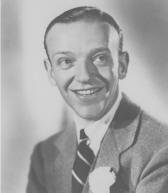Omaha Innovators
Omaha Innovators: A look at some of the best and brightest to hail from our great city.
- Fred Astaire
- Gutzon Borglum
- Marlon Brando
- Karl Connell
- Robert Daugherty
- Henry Doorly
- Wynonie Harris
- John Markoe
- William McKeen
- Carl Renstrom
- Joe Ricketts
- Joe Saunders
- Fred Simon
- Todd Storz
- Carl Swanson
Fred Astaire was a 20th century stage and musical film legend who captivated the imagination of the American public through his unique dance routines, toe-tapping rhythms, and magically graceful movements. Even Americans today who have never seen Astaire dance know that his name means something special and is spoken of with a reverence that credits him as the best of the best.
Astaire was born in 1899 in Omaha where he lived with his parents and older sister Adele. From 1905 to 1932, he and Adele formed a famous dancing duo that charmed audiences from Omaha to New York to London. When Adele retired in 1932, Astaire left for Hollywood. His first job was co-starring in a movie musical with Ginger Rogers. This began Astaire’s forty years of dancing on the movie screen and his ascent to becoming one of the most admired dancers of all time.
Although he frequently referred to himself as “just a hoofer,” Astaire presented to the world his own innovative style of dance that he liked to call his “outlaw style.” With minimal help from professional choreographers, Astaire composed dance routines that were a unique fusion of ballet, ballroom and tap. He also brought a level of perfected performance that has yet to be surpassed by another dancer.
Astaire loved to dance, but it was his creativity, hard work and uncompromising commitment to excellence that made him successful. In 1949, Astaire was given a special award for his “unique artistry and his contributions to the technique of musical pictures.” In 1981, he received the American Film Institutes Life Achievement Award.
Astaire revolutionized the movie musical industry and changed the dancing community forever. From Gene Kelly to Michael Jackson, Astaire’s work influenced hundreds of dancers. Famous ballet choreographer George Balanchine once said, “Astaire’s best was unsurpassed…He is the most inventive, the most elegant dancer of our times…You see a little bit of Astaire in everybody’s dancing – a pause here, a move there. It was all Astaire’s originally.”
Sources:
Vertical Files, Douglas County Historical Society Library Archives Center
 Gutzon Borglum, the sculptor of Mount Rushmore, spent a portion of his youth in Omaha, attending Creighton Prepatory School for a time. Borglum studied sculpting and painting throughout the U.S. and in Paris. He gained recognition as a sculptor for his large public art projects, including a bust of Abraham Lincoln for the rotunda of the U.S. Capitol.
Gutzon Borglum, the sculptor of Mount Rushmore, spent a portion of his youth in Omaha, attending Creighton Prepatory School for a time. Borglum studied sculpting and painting throughout the U.S. and in Paris. He gained recognition as a sculptor for his large public art projects, including a bust of Abraham Lincoln for the rotunda of the U.S. Capitol.
Borglum’s first mountain-carving commission was a tribute to the Confederate Army on the side of Stone Mountain outside Atlanta. Carving was arduous and initially done by hand, until Borglum and his engineers developed methods to blast the rock with dynamite and then refine it with jackhammers and chisels. Time delays, cost overruns and disagreements led Borglum to quit the Stone Mountain project — but not before his next mountain-carving commission was in the works.
 That next project was an even larger carving in the mountains of the Black Hills. Borglum likened the carving of Mount Rushmore to the building of the Great Pyramids; an effort that would last beyond civilization as we know it today. Borglum’s suggested theme of “Manifest Destiny,” encompassing the founding, growth, preservation and development of the nation was eventually accepted by South Dakota and Calvin Coolidge, the U.S. President in 1927, when work on the mountainside began.
That next project was an even larger carving in the mountains of the Black Hills. Borglum likened the carving of Mount Rushmore to the building of the Great Pyramids; an effort that would last beyond civilization as we know it today. Borglum’s suggested theme of “Manifest Destiny,” encompassing the founding, growth, preservation and development of the nation was eventually accepted by South Dakota and Calvin Coolidge, the U.S. President in 1927, when work on the mountainside began.
Gutzon Borglum died on March 6, 1941 before carving on Mount Rushmore was completed. His son, Lincoln, spent another season working at Mount Rushmore but left the monument largely in the state of completion it had reached under his father’s direction. Borglum’s widow reflected on why her husband chose to sculpt mountains. It was, simply, “the emotional value of volume.” For anyone who has ever gazed upon Mount Rushmore, they understand.
Sources:
Vertical Files, Douglas County Historical Society Library Archives Center
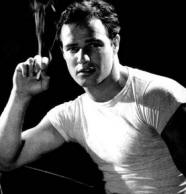 Marlon Brando, often referred to as the greatest movie actor of all time, was born in Omaha on April 3, 1924. His parents and older sister, Jocelyn, were active in the Omaha Community Playhouse and the family often associated with the likes of the young Henry Fonda and Dorothy McGuire until their relocation to Illinois when Brando was about six. Brando’s home life was less than ideal. His father’s job as a traveling salesman kept him away from home often, and his mother was an alcoholic. Never a model student, a teenage Brando was sent to a military academy that he was subsequently expelled from for riding a motorcycle through the hallways. A bad knee kept him from enlisting in the Army, and a stint digging ditches helped him decide in 1943 to join Jocelyn in New York City, where she had gone to pursue acting.
Marlon Brando, often referred to as the greatest movie actor of all time, was born in Omaha on April 3, 1924. His parents and older sister, Jocelyn, were active in the Omaha Community Playhouse and the family often associated with the likes of the young Henry Fonda and Dorothy McGuire until their relocation to Illinois when Brando was about six. Brando’s home life was less than ideal. His father’s job as a traveling salesman kept him away from home often, and his mother was an alcoholic. Never a model student, a teenage Brando was sent to a military academy that he was subsequently expelled from for riding a motorcycle through the hallways. A bad knee kept him from enlisting in the Army, and a stint digging ditches helped him decide in 1943 to join Jocelyn in New York City, where she had gone to pursue acting.
In New York, Brando enrolled in acting classes at the now famous Dramatic Workshop of The New School and the Actor’s Studio. It was through his studies that Brando was introduced to “The Method” style of acting, whereby the actor “engenders in themselves the thoughts and emotions of their characters in an effort to create lifelike performances.” Brando so excelled in this new form of acting that today his name is often synonymous with its “marbles in the mouth” style of acting.
After only a year of acting school and a season of summer stock theater, Brando made his Broadway debut in the role of Nels in “I Remember Mama”. This would be the first of many stage roles Brando would own, including his most famous role playing Stanley Kowalski in “A Streetcar Named Desire”.
By early 1948, with less than five years of acting to his credit, Look Magazine described Brando with these words: “A poet’s face, a football player’s physique and a volcanic personality make him a perfect figure around which to build a legend.”
But in 1949 Brando famously left the stage to devote himself completely to film. Many critics say he squandered his talent, but before his death on July 1, 2004, he would star in forty-four films, collecting eight academy award nominations and two wins as Terry Malloy in “On the Waterfront” and as Vito Corleone in “The Godfather”.
Sources:
Vertical Files, Douglas County Historical Society Library Archives Center
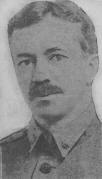 As a talented physician and surgeon, Karl Connell took a special interest in studying various gases and their chemical compositions. A graduate of Omaha (Central) High School and Creighton Medical College, Connell’s study led to two key medical science contributions.
As a talented physician and surgeon, Karl Connell took a special interest in studying various gases and their chemical compositions. A graduate of Omaha (Central) High School and Creighton Medical College, Connell’s study led to two key medical science contributions.
Connell particularly sought to improve to use of anesthetics during surgery. Through his research, he invented the “Connell Ether Vaporizer”. It significantly reduced the dangers of undergoing anesthesia by allowing doctors to administer consistent and controlled dosages throughout any length of time. Due to its effectiveness, the vaporizer was eventually utilized in many prominent hospitals across the United States.
In 1917, when the United States entered into WWI, Connell joined the American Expeditionary Forces as a major in the division of chemical warfare. Due to his specialized knowledge of gases, Connell was commissioned by General John J. Pershing to create an effective shield against deadly gases being used by German soldiers. He experimented with various concentrations of gases and tested the efficiency of several models of gas masks. Not satisfied with the inadequate performance of the traditional gas mask, Connell constructed a new type of gas mask. He created a mask that completely protected soldiers from all gases used during WWI.
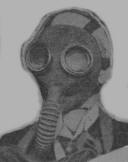 The improved gas mask was known as the “Connell” or “Victory” mask. The “Connell” mask became the standard gas mask issued by the United States war department. In 1923, Connell was awarded the Distinguished Service Medal by the United States Department of War for developing a superior gas mask that unquestionably saved lives.
The improved gas mask was known as the “Connell” or “Victory” mask. The “Connell” mask became the standard gas mask issued by the United States war department. In 1923, Connell was awarded the Distinguished Service Medal by the United States Department of War for developing a superior gas mask that unquestionably saved lives.
Sources:
Vertical Files, Douglas County Historical Society Library Archives Center
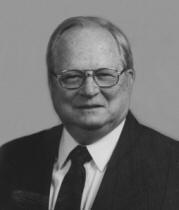 The year was 1946 and Robert B. Daugherty, an Omaha native and returning WWII Marine, was looking for a business opportunity. Although not formally trained in agriculture, Daugherty had been exposed to the agricultural business helping his father with his work as a commission man at the Omaha Stockyards. Daugherty’s uncle advised him to investigate a small agricultural operation in Valley, Nebraska and its lone product, a crop elevator – a device farmers could use to lift crops into a corn crib or barn. Daugherty paid $5,000 for half interest in the operation, run by two to three employees depending on sales.The new partners renamed the operation Valley Manufacturing, and Daugherty set off promoting their product.
The year was 1946 and Robert B. Daugherty, an Omaha native and returning WWII Marine, was looking for a business opportunity. Although not formally trained in agriculture, Daugherty had been exposed to the agricultural business helping his father with his work as a commission man at the Omaha Stockyards. Daugherty’s uncle advised him to investigate a small agricultural operation in Valley, Nebraska and its lone product, a crop elevator – a device farmers could use to lift crops into a corn crib or barn. Daugherty paid $5,000 for half interest in the operation, run by two to three employees depending on sales.The new partners renamed the operation Valley Manufacturing, and Daugherty set off promoting their product.
The fledgling company’s big break was a contract with Sears and Roebuck Co. for 1,000 elevators. By 1952 there were 100 employees and other agricultural products had joined the line. When a farm recession hit and sales slowed, Daugherty knew the company needed to diversify. An employee told him about Nebraska inventor Frank Zybach, who was tinkering with a center pivot irrigation device. Daugherty decided to pay him a visit. The technology wasn’t proven, but he found it intriguing. In 1954, Daugherty bought the patent rights from Zybach and his brother-in-law cum partner, A. E. Trowbridge, for 5 percent of future royalties.
Daugherty now admits that the first systems were not reliable and farmers did not initially see their value, but he and his manufacturing team persevered and continued to make technical improvements to the system. Between 1962 and 1965 sales took off. As Daugherty stated, “It was a matter of product emergence from the developmental state.” In June 1976, Scientific American magazine called center pivot irrigation systems “perhaps the most significant mechanical innovation in agriculture since the replacement of draft animals by the tractor.”
Today we know Bob Daugherty’s small start-up company as Valmont Industries, Inc., a combination of the names of the two towns (Valley and Fremont) closest to its original manufacturing facility. The company is now headquartered in Omaha, but building irrigation systems still comprises a large portion of its operations. And, in a nod to Daugherty’s business cornerstone of diversification, the company also produces pole structures, tubular products and metal coatings for steel products.
Sources:
Vertical Files, Douglas County Historical Society Library Archives Center
 A brief biography of Henry Doorly must begin with his birth in Bridgewater, Barbados, British West Indies on November 9, 1879. Finding very little opportunity for employment in Barbados, Doorly came to the United States in 1898 and got a job surveying for the Union Pacific Railroad in Wyoming. This introduced Doorly to weather unlike anything in Barbados: snow and below zero temperatures. He also spent time as a draftsman for the Union Pacific and the Corps of Engineers in Omaha.
A brief biography of Henry Doorly must begin with his birth in Bridgewater, Barbados, British West Indies on November 9, 1879. Finding very little opportunity for employment in Barbados, Doorly came to the United States in 1898 and got a job surveying for the Union Pacific Railroad in Wyoming. This introduced Doorly to weather unlike anything in Barbados: snow and below zero temperatures. He also spent time as a draftsman for the Union Pacific and the Corps of Engineers in Omaha.
At the Field Club, where he organized a cricket club, he met Margaret Hitchcock, daughter of the publisher of the Omaha World-Herald newspaper. Soon they were engaged, and Margaret’s father offered young Henry a job working for the paper. His career there took him from want ad salesman to business manager. In 1934 he became the newspaper’s publisher following the death of Gilbert Hitchcock.
 In 1942, less than a year after the country’s entry into World War II, Doorly became the driving force behind the fabulously successful scrap metal drives. Starting with a statewide contest that pitted county against county, the drives eventually spread across the country. Factories used scrap metal to augment steel in the production of everything from bullets to tanks. As a result of the drives and subsequent boost in the U.S. military campaign, the World-Herald won a Pulitzer Prize for public service.
In 1942, less than a year after the country’s entry into World War II, Doorly became the driving force behind the fabulously successful scrap metal drives. Starting with a statewide contest that pitted county against county, the drives eventually spread across the country. Factories used scrap metal to augment steel in the production of everything from bullets to tanks. As a result of the drives and subsequent boost in the U.S. military campaign, the World-Herald won a Pulitzer Prize for public service.
In addition to his life with the World-Herald, Henry Doorly took a very active role in many civic endeavors. In 1943, when the polio epidemic underlined the need, he conceived the idea and was responsible for founding and supporting Children’s Memorial Hospital. He also worked for the conversion of the Nebraska Power Company, a private corporation, to the citizen-owned Omaha Public Power District.
Other awards were achieved for the National Association of Soil Conservation Districts and a 1952 traffic safety campaign that cut auto fatalities by 30 percent.
Today, the name Henry Doorly is most widely recognized in conjunction with Omaha’s world famed zoo. In Henry Doorly’s honor, his widow donated $750,000 to raise it from a small municipal zoo to its present world class status.
Sources:
Vertical Files, Douglas County Historical Society Library Archives Center
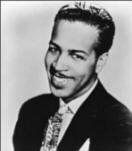 Flamboyant and bawdy – with a slew of songs about whiskey, women and good times – Wynonie Harris ruled the rhythm and blues charts from the late 1940s to the mid-50s. His energetic brand of jump blues profoundly influenced rock ‘n’ roll music.
Flamboyant and bawdy – with a slew of songs about whiskey, women and good times – Wynonie Harris ruled the rhythm and blues charts from the late 1940s to the mid-50s. His energetic brand of jump blues profoundly influenced rock ‘n’ roll music.
Biographer Tony Collins points out the singer’s “disarmingly cheerful vulgarity” as a major reason for his success. On titles such as “Good Rockin’ Tonight,” “All She Wants to Do is Rock” and the self-composed “Shake That Thing”, he is both lewd and fun-loving. Harris and the various combos he fronted sound like they’re having a raucous time, and his live performances were equally wild. Usually clad in a tuxedo, the handsome Harris also owed his popularity to his appeal to women.
Born in Omaha in 1913, Harris attended both Technical and Central High Schools before abandoning his studies for a try at show business. He got his first chance at stardom in 1935 at Jim Bell’s Harlem, a lavish club near 24th and Lake Streets in Omaha. Here he danced, played drums and got his first shot at singing the blues. During the next five years, he became the top singer in Omaha.
He moved to Los Angeles in 1940 and made a name for himself there, earning the nickname “Mr. Blues”. Harris joined one of the top touring bands, the Lucky Millinder Orchestra, which featured fellow Omahan Preston Love on alto sax. One of the first numbers Harris recorded with the band, the spirited “Who Threw the Whiskey in the Well”, became a hit with both black and white audiences. Crossover hits eluded Harris most of the rest of his career, even though he scored three Number One hits and 16 Top Ten hits on the R&B or “race” charts.
 Though he remains largely unknown in his native city, Harris has received some recognition for his trailblazing musical efforts. In the 1990s Harris was inducted into the Nebraska Rock ‘N’ Roll Hall of Fame and the W.C. Handy Blues Hall of Fame. His recording of “Good Rockin’ Tonight” is included in the Cleveland-based Rock and Roll Hall of Fame’s list of “500 Songs That Shaped Rock and Roll”.
Though he remains largely unknown in his native city, Harris has received some recognition for his trailblazing musical efforts. In the 1990s Harris was inducted into the Nebraska Rock ‘N’ Roll Hall of Fame and the W.C. Handy Blues Hall of Fame. His recording of “Good Rockin’ Tonight” is included in the Cleveland-based Rock and Roll Hall of Fame’s list of “500 Songs That Shaped Rock and Roll”.
Sources:
Vertical Files, Douglas County Historical Society Library Archives Center
Collins, Tony, Rock Mr. Blues: The Life & Music of Wynonie Harris, Milford NH: Big Nickel Publications, 1995
 An All-American football player and graduate of West Point with Dwight Eisenhower and Omar Bradley; a soldier who was jailed for drunkenness in a Mexican saloon and later drummed out of the Army; a lumberjack in Minnesota; a buck private in the Minnesota Guard who was called back for active duty during World War I; a Roman Catholic priest who had given up drinking and smoking but was kicked out of St. Louis University for being a civil rights activist; a mathematics professor at Creighton University. All this describes Fr. John Markoe, S.J.
An All-American football player and graduate of West Point with Dwight Eisenhower and Omar Bradley; a soldier who was jailed for drunkenness in a Mexican saloon and later drummed out of the Army; a lumberjack in Minnesota; a buck private in the Minnesota Guard who was called back for active duty during World War I; a Roman Catholic priest who had given up drinking and smoking but was kicked out of St. Louis University for being a civil rights activist; a mathematics professor at Creighton University. All this describes Fr. John Markoe, S.J.
During his stay in St. Louis with his brother William, who was working with poor blacks, Fr. Markoe first realized the prejudice they faced. In Omaha he decided he could and should do something to combat the racism he saw all around. With the encouragement of a few courageous students, Fr. Markoe founded the De Porres Club in 1947. Named after a Peruvian saint of mixed ancestry, the stated purpose of the club was “to educate people to think along the lines of charity and justice as regards inter-racial matters.” After meeting the first year at Creighton, they were asked to move because they were too controversial. Several locations in North Omaha became their home.
Although other cities in the nation became famous for racial activism, Omaha was really the first to have sit-ins at restaurants and bus boycotts. The fledgling group gained credibility when it eventually allied itself with the local chapter of the NAACP, the Omaha Urban League, and local black ministers. By the 1960s the De Porres Club was on its way out, its functions being assumed by the black power movement and the passage of civil rights laws.
Even after his retirement from teaching duties at Creighton, Father Markoe worked toward racial harmony and improved living conditions for Omaha blacks. He died July 26, 1967, but will long be remembered as a champion of social justice.
Sources:
Vertical Files, Douglas County Historical Society Library Archives Center
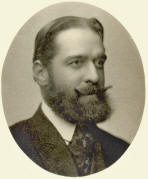 William Riley McKeen, a trained mechanical and electrical engineer, is best known as the inventor of the McKeen Motor Car. Coming from a railroad family, he worked his way up to superintendent of motive power and mechanics for the Union Pacific Railroad. He had the complete confidence of railroad boss E.H. Harriman, at one time getting new shops built for over $1 million.
William Riley McKeen, a trained mechanical and electrical engineer, is best known as the inventor of the McKeen Motor Car. Coming from a railroad family, he worked his way up to superintendent of motive power and mechanics for the Union Pacific Railroad. He had the complete confidence of railroad boss E.H. Harriman, at one time getting new shops built for over $1 million.
When Harriman saw the need for a more economical way to transport passengers over branch lines, he called on McKeen to design a self-propelled rail car, which would be much cheaper to operate than the steam-engined passenger trains of the day. McKeen’s design was a very streamlined shape which was powered by a gasoline engine (originally 100 horsepower, later 200 horsepower).
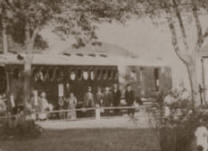 The standard McKeen Motor Car, with its distinctive porthole windows, carried 75 passengers. Inlaid mahogany, maple flooring and leather or rattan seat upholstery gave the interior an elegant appearance.
The standard McKeen Motor Car, with its distinctive porthole windows, carried 75 passengers. Inlaid mahogany, maple flooring and leather or rattan seat upholstery gave the interior an elegant appearance.
The concept was so successful that a separate company, the McKeen Motor Co., was formed to build the cars in a leased building in the Union Pacific Shops. In 1906, 20 cars were shipped east to used as demonstrators, which caused a great demand for more units. From 1905 to 1917 over 150 cars were built and sold to over 50 railroads across the country. The company was sold back to the Union Pacific in 1918. William McKeen ultimately retired to an avocado ranch in California where he died in 1946 at the age of 77.
Sources:
Vertical Files, Douglas County Historical Society Library Archives Center
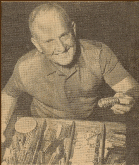 Carl W. Renstrom founded Tip-Top Products Company in Omaha in 1932 with just $5 capital then went looking for the next big idea – not the most conventional way to start a business during the Great Depression. While selling door-to-door, Renstrom had crossed paths with a gentleman selling heatless liquid solder in a can.
Carl W. Renstrom founded Tip-Top Products Company in Omaha in 1932 with just $5 capital then went looking for the next big idea – not the most conventional way to start a business during the Great Depression. While selling door-to-door, Renstrom had crossed paths with a gentleman selling heatless liquid solder in a can.
Renstrom tried to convince the man to form a company with him, but when he was rebuffed, he set about replicating the unpatented solder in a squeezable tube. He then mounted multiple tubes on a placard for easy display within stores. The solder was an immediate success and gave Renstrom the financial security to expand, but that meant he needed another big idea.
His sister had returned from Europe with a cheaply made metal hair curler that she loved. Similar curlers were selling in the U.S. for about 5 cents each. Again, Renstrom thought he could improve on the design an packaging. His product was called the Tip Top Easy Curler – four aluminum curlers on a card priced at 10 cents a card. Millions of women responded with their pocketbooks.
 By 1936 Renstrom filed his first of many hair product patents. He had found his niche. When WWII intervened and aluminum was at a premium, he retooled the machines that had once produced curlers to fabricate military wire reels, barbed wire throws and land mine crates, all the while experimenting with plastic. When the war ended, he converted his line to plastic. By 1964, when Tip-Top Products Company was sold to the Rayette Co. (later named Faberge) for $25 million, Renstrom and his company were producing 650 different hair products.
By 1936 Renstrom filed his first of many hair product patents. He had found his niche. When WWII intervened and aluminum was at a premium, he retooled the machines that had once produced curlers to fabricate military wire reels, barbed wire throws and land mine crates, all the while experimenting with plastic. When the war ended, he converted his line to plastic. By 1964, when Tip-Top Products Company was sold to the Rayette Co. (later named Faberge) for $25 million, Renstrom and his company were producing 650 different hair products.
Sources:
Vertical Files, Douglas County Historical Society Library Archives Center
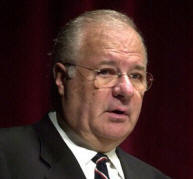 John J. “Joe” Ricketts started one of the country’s first discount brokerage firms in 1975 with a $12,500 investment. During the next 25 years – through sound business practices, technological innovations and acquisitions – Ricketts assembled TD Ameritrade into a powerhouse of the financial services industry.
John J. “Joe” Ricketts started one of the country’s first discount brokerage firms in 1975 with a $12,500 investment. During the next 25 years – through sound business practices, technological innovations and acquisitions – Ricketts assembled TD Ameritrade into a powerhouse of the financial services industry.
Ricketts bought out his partners in 1982. His company, then AmeriVest, introduced the first quote and order entry system that used a touch tone telephone in 1988. He was a pioneer in flat-rate trading, partnering with Ceres Securities. In 1994 his company became the first firm to offer securities trading over the internet. Three years later, Ricketts established eBroker, an internet brokerage firm. Later he united all of them together into Ameritrade, successfully creating one of the country’s largest brokerage firms.
Because of his work schedule, his wife’s busy schedule as an Omaha Public Schools teacher, and a growing family, it took Ricketts nine years before earning a bachelors degree from Creighton University.
While at Creighton, Ricketts worked at Dunn & Bradstreet as a credit reporter. Upon graduation, he went to Dean Witter but soon left to start his own firm. Though Ricketts stepped down as chairman in 2008, he will be forever linked with Ameritrade.
In the same year, his company bought the naming rights to the baseball stadium in downtown Omaha, new home to the College World Series.
Sources:
Vertical Files, Douglas County Historical Society Library Archives Center
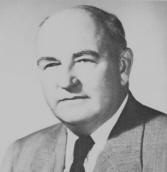 On August 20, 1916, Omaha entrepreneur Josiah Ellis “Joe” Saunders launched the car rental business with a seven-line classified ad announcing “Automobiles for Hire”.
On August 20, 1916, Omaha entrepreneur Josiah Ellis “Joe” Saunders launched the car rental business with a seven-line classified ad announcing “Automobiles for Hire”.
Saunders, whose main business was real estate, placed the ad in the Omaha World-Herald. His fleet consisted of just one automobile – a borrowed Model T Ford. Within six months, Saunders had 18 Model Ts at his business, Ford Livery Company, 317 N. 22nd St. Renting Fords at 10 cents a mile, he soon convinced his three brothers that car rental was a booming business. Even their skeptical father joined the operation, which later became Saunders Drive-It-Yourself System and finally Saunders System.
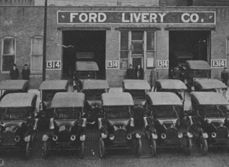 In 1917 the business moved to a much larger garage at 13th and Howard. Within two years it was filled with more than 130 Model T Fords. There seemed to be no shortage of customers. “Cars often were rented just for the experience and pleasure of driving,” wrote Harris Saunders in a book on the company’s history. Though thefts, wrecks and bad accounts were concerns, profits overcame any liabilities.
In 1917 the business moved to a much larger garage at 13th and Howard. Within two years it was filled with more than 130 Model T Fords. There seemed to be no shortage of customers. “Cars often were rented just for the experience and pleasure of driving,” wrote Harris Saunders in a book on the company’s history. Though thefts, wrecks and bad accounts were concerns, profits overcame any liabilities.
Warwick Saunders Sr., the father who had at one time questioned the legitimacy of the business, now pushed his sons to expand. By late 1919 they had a location in Kansas City; the following year they were purchasing 100 Fords from a dealer in Birmingham, Alabama and leasing a new garage there. By 1926 Saunders System operated in 56 cities. The Saunders brothers even dabbled in the “fly-it-yourself” industry.
The Great Depression dealt the business a severe blow, but Saunders System survived. Joe Saunders sold his Chicago operation to Avis in 1955 for $500,000.
Sources:
Vertical Files, Douglas County Historical Society Library Archives Center
Saunders Sr., Harris, Top Up or Down: Car and Truck Renting – the Origin and Development of the Industry – Since 1916. Birmingham, Ala.: Birmingham Printing and Publishing Co., 1985
Omaha City Directories
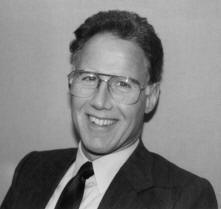 In 1917, a small meat-packing company made its debut on the corner of 17th and Douglas Street. The shop, formerly a carpentry business called the Table Supply Company, was transformed into Table Supply ‘Meat’ Company by its thrifty new owner, B.A. Simon. With the help of his son Lester, Simon shaped the business into a well respected meat company that specialized in servicing restaurants, hotels and the Union Pacific Railroad with prime cuts of beef.
In 1917, a small meat-packing company made its debut on the corner of 17th and Douglas Street. The shop, formerly a carpentry business called the Table Supply Company, was transformed into Table Supply ‘Meat’ Company by its thrifty new owner, B.A. Simon. With the help of his son Lester, Simon shaped the business into a well respected meat company that specialized in servicing restaurants, hotels and the Union Pacific Railroad with prime cuts of beef.
In the 1940s, Lester’s teenage sons Fred, Alan and Steve joined their father and grandfather in the meat business. With the extra hands and a booming market, the Simon family worked to keep up as Table Supply Meat Company grew. In 1952, Lester attempted to further expand the company by selling directly to consumers through mail order. Even though the “mail order venture” was successful, the company was limited to selling to individuals who had easy access to railroad lines. At that time there was no shipping container that could keep individual orders of meat from spoiling as they traveled long distances away from the railway stations.
The Simon family knew if they solved their shipping problems they could serve thousands of customers across the country. In the early 1960s, Fred began experimenting with packaging methods, shipping containers and dry ice. Because no specialized container had ever been created, Fred went directly to the refrigerator manufacturers and asked for smaller cuts of insulation. By 1964, Fred’s efforts paid off and he presented a polystyrene cooler small enough to individually ship a customer’s order that kept the meat adequately frozen for 7 to 8 days.
 Fred’s ingenuity was a turning point for the Simons and Table Supply Meat Company. Within two years the family moved the company to a larger location on 96th Street and changed its name to Omaha Steaks. Fred’s new shipping container helped Omaha Steaks grow from sales of $2.5 million in 1964 to $450 million in 2005. Today, Omaha Steaks is internationally known and respected because of the strong values, vision and creativity of Fred Simon and his family.
Fred’s ingenuity was a turning point for the Simons and Table Supply Meat Company. Within two years the family moved the company to a larger location on 96th Street and changed its name to Omaha Steaks. Fred’s new shipping container helped Omaha Steaks grow from sales of $2.5 million in 1964 to $450 million in 2005. Today, Omaha Steaks is internationally known and respected because of the strong values, vision and creativity of Fred Simon and his family.
Sources:
Vertical Files, Douglas County Historical Society Library Archives Center
DCHS Video Interview Series 2009 “I Remember”: Fred Simon
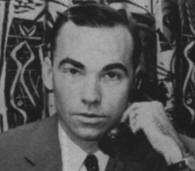 In 1950 Look Magazine predicted that radio would be dead in 10 years, but Todd Storz was just beginning to tinker with a radio format that would quickly propel him to the crest of the wave of AM radio.
In 1950 Look Magazine predicted that radio would be dead in 10 years, but Todd Storz was just beginning to tinker with a radio format that would quickly propel him to the crest of the wave of AM radio.
He did it with a formula that relied on repetition, consistency, vitality and a sense that “something is happening all the time”. Storz wanted to “give the public what they want”, and what became known as “Top 40 radio” did exactly that. Storz once said, “if the public suddenly showed a preference for Chinese music, we’d play it”.
The Storz sound also relied heavily on promotions and giveaways. Disc jockeys with personality, brief, locally oriented news segments and sound effects gave Storz stations a fresh, vibrant feel.
Storz, and his father, Robert, started with a small station in Omaha. Within two years of its purchase in 1949, station KOWH rose from sixth place to first. In fact, it had the highest percentage of listeners of any independent station in the country. The Storz duo purchased other stations in New Orleans, Kansas City, Minneapolis, Miami, and St. Louis. They followed similar patterns of market dominance.
Though he pioneered Top 40, Storz didn’t make it to that age. He died suddenly in 1964 at age 39. But for more than a decade, the name his grandfather made famous on beer bottles reigned supreme in broadcasting.
Sources:
Vertical Files, Douglas County Historical Society Library Archives Center
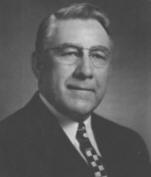 The Omaha-based national food production company that would later become C.A. Swanson and Sons began in 1898 as Jerpe Commission Co., selling butter and poultry products locally. By 1928, Carl A. Swanson was the sole proprietor. Soon sons Gilbert C. and W. Clarke Swanson would join their father to assist with expanding the company’s production and distribution operations. By 1938 the Swanson enterprise was one of the four largest creameries in the U.S., and during WWII became the largest supplier of poultry and egg products to the U.S. military.
The Omaha-based national food production company that would later become C.A. Swanson and Sons began in 1898 as Jerpe Commission Co., selling butter and poultry products locally. By 1928, Carl A. Swanson was the sole proprietor. Soon sons Gilbert C. and W. Clarke Swanson would join their father to assist with expanding the company’s production and distribution operations. By 1938 the Swanson enterprise was one of the four largest creameries in the U.S., and during WWII became the largest supplier of poultry and egg products to the U.S. military.
In 1945, the company’s name was officially changed to C.A. Swanson and Sons. Post-WWII brought significant changes to the country and to C.A. Swanson and Sons. When Carl died in 1949, his sons assumed control of the company.
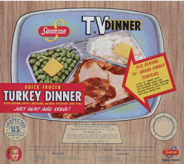 In the U.S., the baby boom was underway and the demand for consumer goods was on the rise. Household freezers were becoming popular as homemakers looked for more convenience in the kitchen. The Swansons, experienced in fast-freezing techniques as a result of a 1923 Birdseye partnership, responded to these growing trends by introducing a frozen chicken pot pie in 1951. The next year the company released a complete frozen turkey dinner for 98 cents. The Swanson trademarked the name “TV Brand Frozen Dinner” for the dinners and designed the product’s packaging to resemble a wood-grained TV set. The “TV Dinner”, as it would come to be known, could not have been a bigger success. By 1955 the company was selling 25 million units annually, and cooking was never the same.
In the U.S., the baby boom was underway and the demand for consumer goods was on the rise. Household freezers were becoming popular as homemakers looked for more convenience in the kitchen. The Swansons, experienced in fast-freezing techniques as a result of a 1923 Birdseye partnership, responded to these growing trends by introducing a frozen chicken pot pie in 1951. The next year the company released a complete frozen turkey dinner for 98 cents. The Swanson trademarked the name “TV Brand Frozen Dinner” for the dinners and designed the product’s packaging to resemble a wood-grained TV set. The “TV Dinner”, as it would come to be known, could not have been a bigger success. By 1955 the company was selling 25 million units annually, and cooking was never the same.
Sources:
Vertical Files, Douglas County Historical Society Library Archives Center
